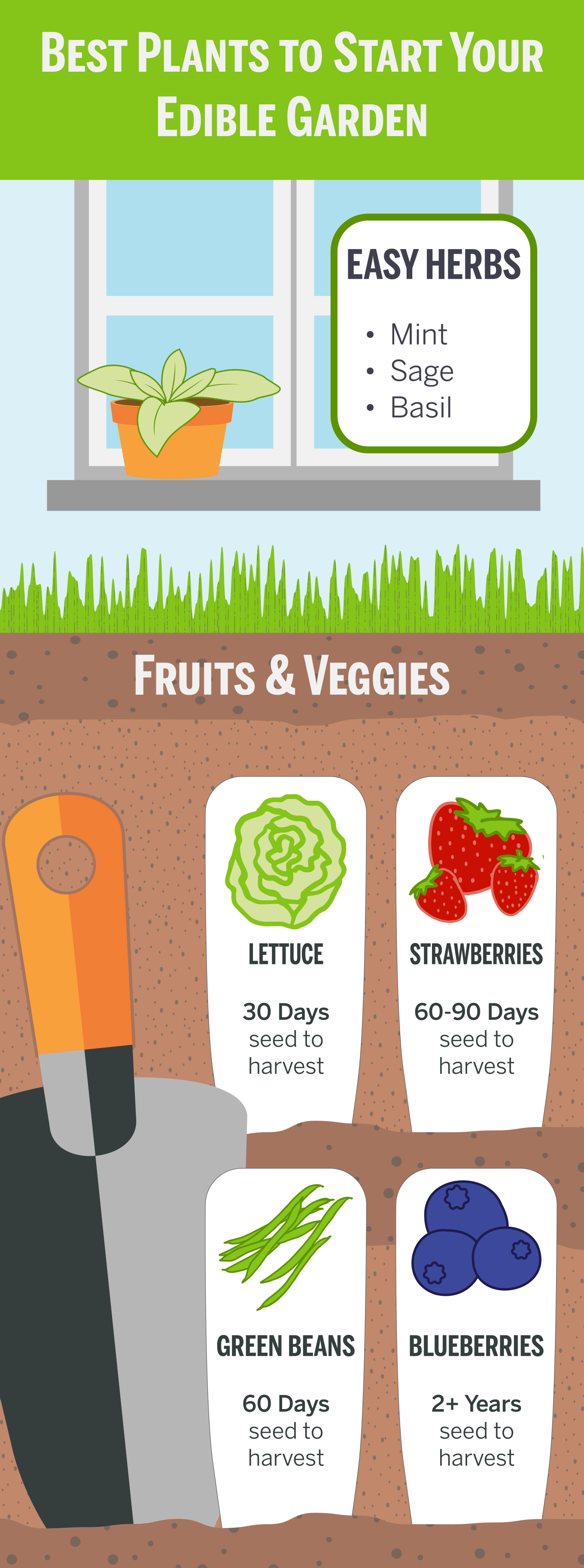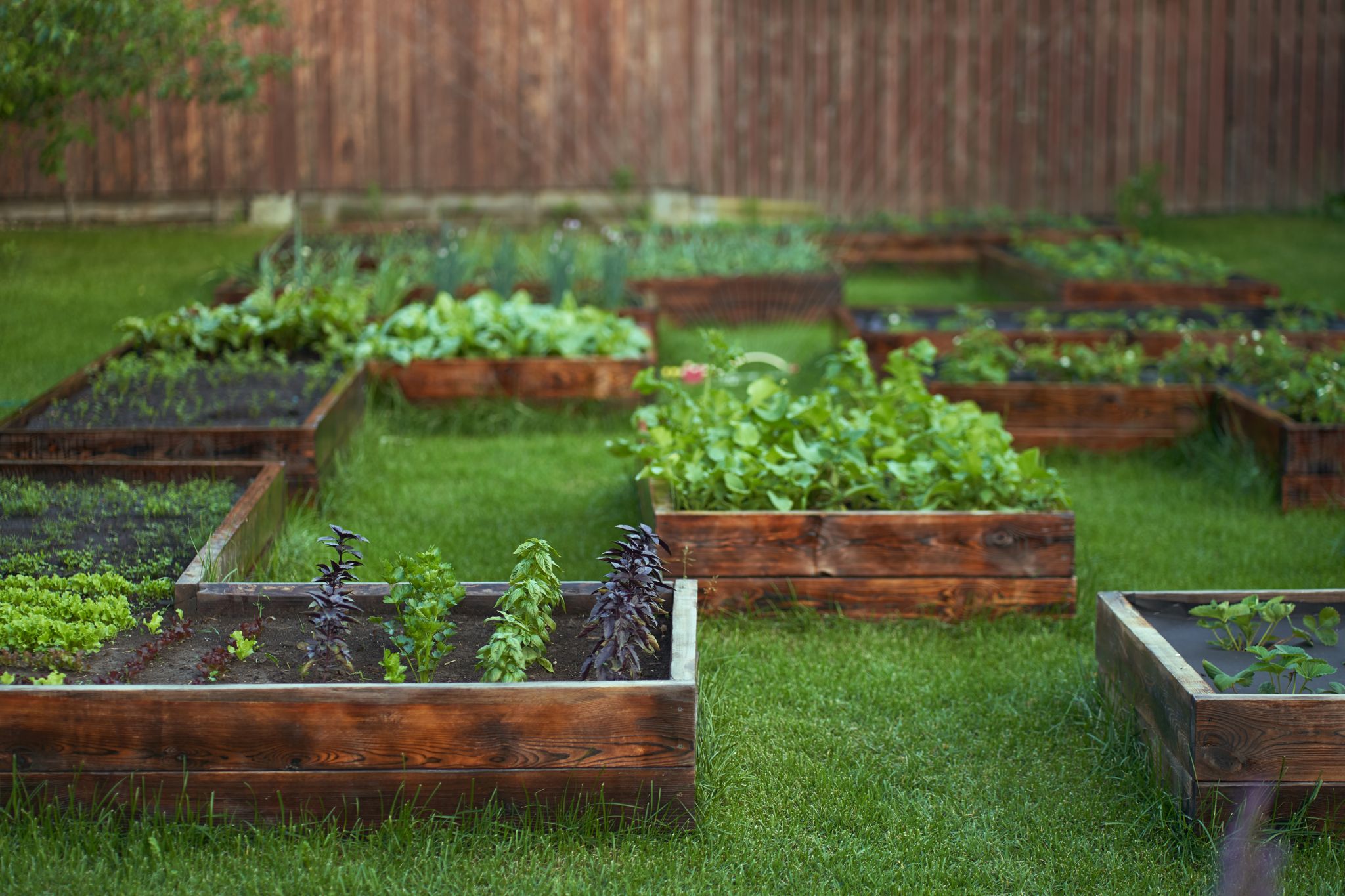Have you been hit by the urge to try vegetable gardening? Yep, us too. These days, part of the motivation might be financial. Grocery prices are stubbornly high, despite declining inflation in other areas. Even if you aren’t planning a full-on crop of tomatoes and cucumbers, benefits other than financial include less waste, more family and outdoor fun, and even better health.
Those benefits have persuaded consumers to start gardening. In fact, 25% of American homeowners grow their own berries, vegetables, or fruit trees, according to the National Initiative for Consumer Horticulture.
A dose of gardening is also good for your body and mind, reports Ohio State University. It even puts you in a better mood because it activates serotonin, the feel-good hormone, says Ohio State.
If you think a veggie garden would turn your backyard into a buggy mess, no worries. We’ve got tips to get you started so your garden looks good while you’re setting up for a harvest.
Get Growing: Top 8 Tips for Starting Your Veggie Garden
Whether you’re interested in vegetable gardening or some other edible type, you’ll need to lay the groundwork. After all, preparation leads to success.
#1 Connect With Local Resources About Veggies for Your Region
Local resources are the best kind, says Desiree Sims, owner and head gardener of Peas and Love Edible Gardening Company in St. Petersburg, Fla. That’s because of the variation in what grows in what region in which season.
Start by looking up your USDA grow zone to see which plants do best in your region. Then, find local sources to narrow down plant varieties and seasons.
“Connect with a local plant nursery because they’re really the experts on what grows well in your location,” Sims says. “They usually have seeds too, but if not, you can connect to your local extension office.” The U.S. Department of Agriculture partners with universities in every state to create extension offices that give communities access to local, research-based information on all things gardening.
#2 Plan Your Veggie Garden Planting Space
Whether you have a sprawling back yard or a condo balcony, a veggie garden is possible. For example, vertical gardens offer space efficiency for those with little space, Sims says. “They take up about two feet of space on the ground. A vertical garden that’s two feet at the base but five feet tall can fit up to 50 plants.”
For those with backyard space, you’ll need to figure out whether to plant directly in the ground or use raised beds, which work well when ground soil isn’t viable for growing, Sims says. Raised beds are also a good idea in states like Arizona, Florida, and Georgia, where the soil is sandy, desertlike, or heavy on clay.
#3 Aim for a Tidy Veggie Garden Space and Enough Sun
Your goal is to keep your veggie garden looking tidy rather than a sprawling mess. “Simply put, raised garden beds or a modular garden bed is the top choice for maintaining a well-defined edible garden,” says Jeff Collard, a horticulturist who works with True Leaf Market, an online seed retailer based in Salt Lake City. “It not only better defines the space and looks visually appealing, but also helps any running, spreading or trailing plants not to creep out into the turf or yard as easily.”
Orienting your garden east to west will help your veggies, fruit, or herbs get uniform sunlight throughout the day, says Alex Kantor, owner of Perfect Plants Nursery in Florida’s panhandle.
Factor in how much sun a certain area gets before deciding what to plant. “The best way to do this is to walk into your yard at various times throughout the day to see if the sun is shining on that spot,” Sims says. You want to plant a vegetable garden in an area that gets about six hours of sunlight per day.
#4 Figure Out Your Veggie Garden Bed Size and Design
The length of the bed or row should typically range from four feet to eight feet. “You need to be able to reach the middle of the bed,” says Sims. “If kids will be gardening, keep their reach in mind.”
Kantor recommends a pyramid design, where plants that will grow tall are placed in the middle, herbs are along the outside, and spreading plants like squash are in the corners so they have room to trail a bit over the bed when needed.
#5 Prep the Soil for Your Veggie Garden
To make sure soil is balanced, you might have to amend it, which means adding things to make the soil suitable for growing healthy plants. “Adding ‘amendments’ to garden soil is an absolute must in almost any region,” says Collard. “Most backyards have been compacted and drained from nutrients over the years because of construction and building and water runoff.”
Cleaning chemicals and pesticides often pollute a backyard, so you can help revitalize outdoor and backyard soils by adding supplements like compost or cow manure and peat moss, and volcanic crushed stone, vermiculite, or perlite, he adds. When in doubt, consult your extension office.
#6 Start With Easy Veggie and Fruit Options

One of the best parts of vegetable gardening is the first harvest. Some plants and herbs bear heartier veggies and fruit more quickly than others. For (mostly) quick progress on veggies, fruit, and herbs, Sims and Kantor recommend these options, starting with vegetables:
- Green beans — They’re super hardy, and the seed-to-harvest period is about 60 days.
- Lettuce — Seed to harvest takes about 30 days.
- Potatoes — Sweet and russet potatoes are easy to grow with little maintenance.
- Squash and zucchini — They’re easy to grow with little maintenance and produce a plentiful harvest.
For fruit and herbs, here are some easy choices to start with:
- Blueberries — They’re hardy and easy to grow, but it can take two years for the bush to bear fruit.
- Strawberries — They love full sun, and the seed-to-harvest period is 60 to 90 days.
- Basil — Seed to harvest takes three to four weeks, and it loves full sun.
- Mint — It’s easy to grow with little care but can take over a garden bed, so grow it in a pot. Caution: Mint shouldn’t be planted next to basil or sage. The proximity may make them taste different and stunt their growth.
- Sage — It’s also easy to grow without much care and has a long growing season.
#7 Get Your Veggie Garden Watering Right
First-time veggie gardeners may have trouble with watering volume, Kantor says. “When leaves are turning yellow, that’s due to overwatering. If they’re wilting and turning brown, that’s a sign of underwatering.”
To prevent watering issues, he recommends automating the watering system, using small digital timers found in a local hardware store or online, and a standard soaking hose. “Use a water source at your home, like a spigot, connect the soaker hose to it, and the timer to the soaker hose. Then you just snake the hose through the garden bed at the base of the plants.”
#8 Prevent a Pest Takeover of Your Veggie Garden
The best way to prevent pests is to keep your garden healthy, says Sims. “Make sure the soil is well fed and healthy, that your garden gets adequate sunlight and moisture for its needs, and that you’re planting the right plant at the right time of year.”
Among the peskiest pests are aphids, “tiny bugs that suck the sap out of your plants,” Sims says. “The best way to get rid of them is to use your hose to blast them off with water.”
Another option is “companion planting,” which is planting certain flowers, herbs, or veggies that naturally deter pests, Collard says. For instance, garlic and green onion will drive away aphids, and leeks and chives will ward off spider mites.
Growing your own fresh vegetables, fruit, and herbs offers many benefits — savings and less waste, to name a couple. But don’t forget about the quality-of-life perks, like family fun on a shared project, better health, more time outside, and a change of scenery in your backyard.
